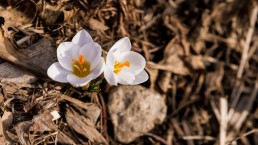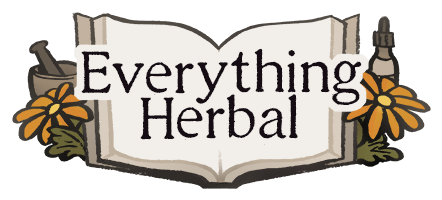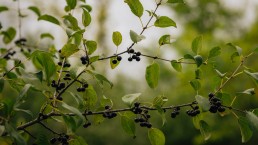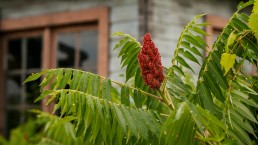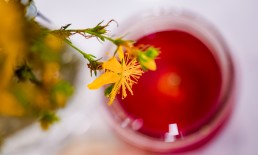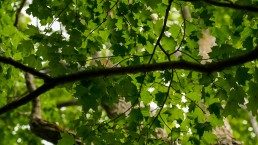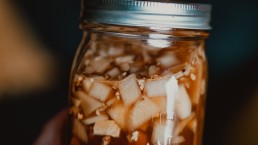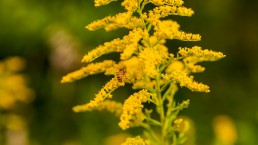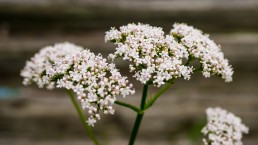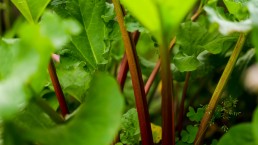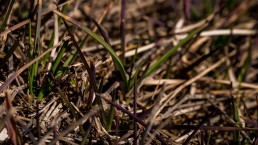Old Fence Rows and Buckthorn
Spring is Ever Drawing Nearer
My fingers are itching to be in the earth once more – to sow and plant — bringing me into a deeper connection with the Earth once more. Our seeds have all been delivered and our trees ordered, and we are already busy here on the farm. The sugar shack is getting a new wind break and the chainsaw is sharpened and ready to go. With the snows melted and frost still in the ground it is the perfect time of year to work away at controlling the invasive Buckthorn.
As many of you know, besides being a clinical herbalist, educator and tea blender extraordinaire (a tea nut to some), we are a botanical sanctuary member of United Plant Savers. Gifting back to the Earth, thankful for all she has gifted us, especially plant medicine. So, we have been busy planting and rewilding for over thirty years now. Our goal is to plant as many endangered and native medicinal plants and trees as we can each spring and fall.
Over the years, we have had a few comments about the non-native species growing and thriving on the farm, people encouraging me to consider digging them all out, eradicate the invasive species from the land.
(Invasive species: “An organism that is not indigenous, or native, to a particular area.”)
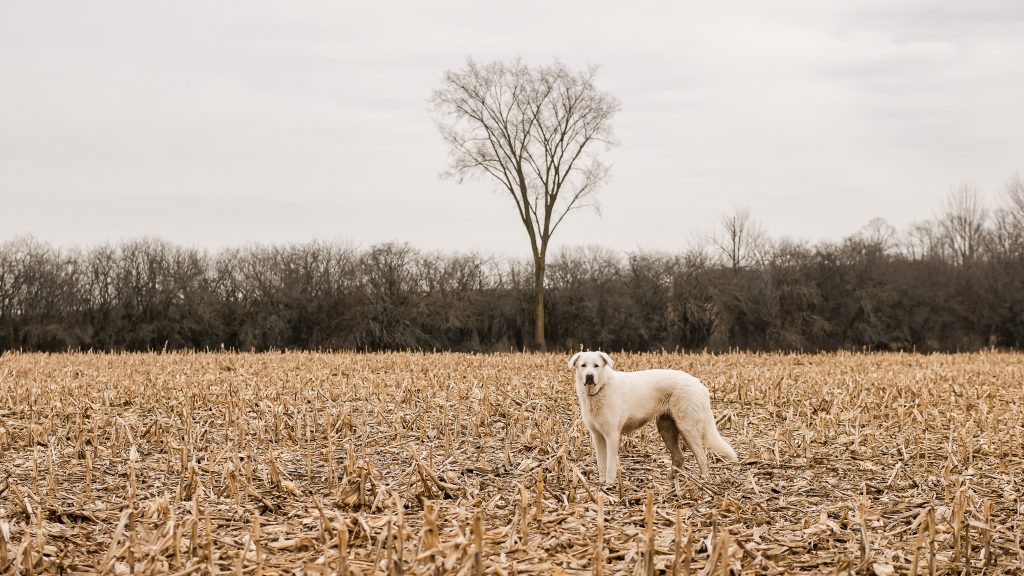
This is easy to say for a person who is not doing the ‘work’ or not possessing a strong love for all who grow and live on these one hundred acres of land. Do we cut down non-native trees, who’s limbs hold nests of baby birds? Do I pluck every Plantain plant from the land? Do we dig up the lilacs brought with the pioneers, that still grace this farmstead — reminders of days gone by? What about her fragrant blossoms that the pollinators seek out each spring? Think about the connection they have already formed to this land.
What about the invasive species that take over an area and swallow up what was there before? These I am trying my best to keep in check and harvest freely for medicine — Phragmites and Garlic Mustard, recently appearing. But Buckthorn is a different story – she has literally kept me awake at night – how do I handle this undesirable invasive small tree?

Description of Buckthorn:
Buckthorn’s main stem is erect, with bark smooth, of a blackish-brown colour, on the twigs ash-coloured. The smaller branches generally terminate in a stout thorn, giving it the name Buckthorn. There are many older names by which this shrub has been known: Waythorn and Highwaythorn. The leaves grow in small bunches, mostly opposite. They are egg-shaped and toothed on the edges, small greenish-yellow flowers are produced, which are followed by globular berries about the size of a pea, black and shining when ripe, and each containing four hard, dark-brown seeds.
Medicinal Action and Uses of Buckthorn
Laxative and cathartic.
The berries are used medicinally, collected when ripe and made into a syrup of Buckthorn, which was used as an aperient drink.
Until late in the nineteenth century, syrup of Buckthorn was a most favourite remedy, used as a children’s laxative, but its action was so severe that, as time went on, the medicine was discarded. It is now used almost exclusively in veterinary practice only, being commonly prescribed for dogs, with equal parts of castor oil as an occasional purgative.
Nature’s Wildlife Highway
Buckthorn was brought here with the European settlers as an ornamental bush and to line fencerows. Keeping livestock in and to serve as much needed windbreaks for the newly cleared land. Some people may only see Buckthorn when they look at these old hedgerows, but there, amongst their midst, if you look much deeper you will see the Birch, Wild Apple trees, Maples, Mountain Ash, Basswood, Aspen, Puff balls, Morels and blankets of our beloved woodland flower, the Trout Lily – which takes over seven years to receive her first bloom!
The hedgerows on our farm are over one hundred and twenty-five years old, deep within the bushes and trees are the remains of old rotting cedar zig zag rail fences, that once marked the property boundaries. These rails now offering homes for small critters and insects, slowly decomposing and feeding the soil, and nurturing the surrounding plant life. These fencerows provide wildlife with shelter and food, and well used trails for safe travel. Connecting the travelers to other fence rows and more trails. We can’t forget the help these hedgerows gift our pollinators as well, with over thirty Wild Apple Trees — all a blossom in the spring and a buzz with life. Providing rich pollen and nectar that our bees use for nutritious food and to make their honey. Many of these old fencerows are being cleared on neighbouring farms. Cleared for more workable land and giving the huge farm equipment of today more room to maneuver with ease. Saving the farmer’s valuable time, but at what cost to our wildlife?
Do I dare disturb this delicate ecosystem? Do I disturb the hidden trails within – taking the safety from the Deer, Coyote, Fox, Wild Turkey, Lynx, Fisher, Bear, and many other creatures who frequent these paths. Buckthorn has been a crucial part of the hedgerow, nurturing the young trees and plants. With connections like these the decision is easy, my intuition has always known, the Buckthorn filled fencerows will NOT be disturbed in any way.
This is my heartfelt commitment to this land.
“Look deep into nature, and then you will understand everything better.”
~ Hans Christian Andersen
Photos Provided by Serena Mor
Sumac Lemonade
Staghorn Sumac Season is Here!
Dayna, Alexander (The Ginkgo Tree herbal apprentices) and I made this delicious lemonade and thought you might like to too!
Sumac Lemonade Recipe:
Ingredients:
- 1 cup staghorn sumac berries (~ 3 bunches)
- 1/2 cup sugar
- 1 lemon
- 4 cups water
- Mint for garnish
Directions:
- Pick berry bunches (do not rinse).
- Bring water to a boil, while removing berries from the bunches.
- Add berries to hot water, cover and steep for 15 minutes, then strain using coffee filter.
- Stir in sugar and lemon.
- Chill and serve with mint sprigs and lemon wedge.
Sumac’s Medicinal Uses
- Antioxidant (prevents or inhibits oxidation)
- High in vitamin C
- North American Indigenous peoples used Staghorn Sumac for sore throats, colds, diarrhea and scurvy. It has also been used for cold sores and asthma.

How to Make an Infused Oil & Salve
A Simple Natural Way to Use Herbs Topically For You and Your Family
Kitchen Medicine Making is ideal for minor first aid needs such as; scrapes, rashes, cuts, bruises, inflammation, aching joints and more… Making your own homemade oils/salves/ointments is an amazing addition to your home remedy cabinet. They are very economical and last a reasonably long time and are so simple to make. Once you know how, and what plants to use, you will be making them for everyone! DIY can be so addictive! For me simplicity is always the answer. The following recipes are easy and fun to create.
Infused Oils
Infusing oils allows the plants essence and therapeutic benefits to be drawn into an oil that can be applied to the body externally. They store for long periods of time and are fun and economical to make.

What oil should I use?
There are many pressed oils that will work quite nicely! (Expensive cold pressed oils will be wasted on the heating method)
- Olive oil – inexpensive, nourishing, and good for those with nut/seed allergies. It does have a stronger scent, but is my personal favourite for medicinal ointments.
- Sunflower oil – inexpensive and neutral in scent.
- Almond oil – excellent for dry and sensitive skins, light scent. A more expensive choice.
- Grapeseed oil – best for oily skins as it is light and easily absorbed. A more expensive choice.
What herbs should I use?
Here is a short list of some great herbs to try out for the first time. It is such an amazing feeling to go outside and pick fresh plants for your oil. The trick here is to let your herbs wilt first before adding to the oil. Wilting allows some of the water content to dissipate, preventing your oil from going “off” – rancid or moldy.
- Calendula petals (Calendula officinalis) – Infuses the oil with a beautiful golden orange colour. Amazing for all types of skin healing, a mild anti-microbial.
- St. John’s Wort flower (Hypericum perforatum) – Infuses the oil an amazing red colour. This oil has great success with nerve pain and aching joints. It is also an excellent remedy for the pain and scar reduction of minor burns. It is also anti-viral.
- Rose petals (Rosa spp.) – Pink and deliciously scented, great for cosmetic use and for calming & relaxing remedies.
- Comfrey (Symphytum officinale L.) – Sometimes called knitbone, this amazing green salve has been used traditionally to support superficial wounds, breaks, sprains, bruises, sprains & strains.
- Chickweed (Stellaria media) – Another lovely green salve which offers soothing relief to hot rashes, bug bites, wounds, diaper rash or any type of itchy skin condition.
- Plantain (Plantago) – This healing green salve aids in stings, bug bites, minor wounds, scratches, rashes and dry, irritated skin.
- Goldenrod (Solidago) – Is used topically for muscle cramps and sore muscles. Bonus: can be use to make salad dressing.
How do I infuse my Oil?
Traditional Sun method: my favourite!
This is such a simple way to make your oil! It is also the oldest and highest regarded way to make your infused oil. Simply fill a clear, wide mouthed jar ½ to ¾ with chopped herb, then top with oil. Shake gently to be rid of any air bubbles and ensure all herbs are covered with oil. Steep in sunny window or outside in the full sun, for approximate four – six weeks, shaking gently each day. Strain and pour into a sterilized storage jar and keep in a cool dark cupboard. Don’t forget to label and date!
Note: There are also Quick Pan and Slow Cooker methods if the infused oil is required quicker.
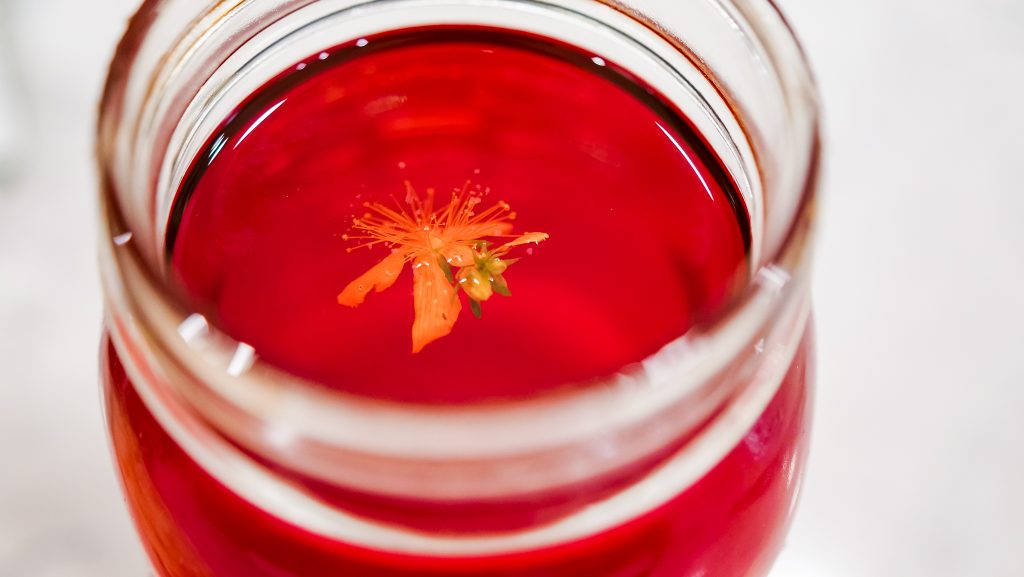
How Do I Make a Salve/Ointment?
Once you have your beautiful solar infused oil you are ready to make your salve… Now this is the magical part!
Take one cup of your infused oil and ¼ cup of beeswax; add to a stainless steel pot and place on burner. Heat low and slow until all the beeswax has melted. Test consistency of salve by taking a spoon full and placing in the freezer for ~5 min. If salve is too hard you can simply add a titch more infused oil to the pan, if too soft simply add a titch more beeswax to pan and melt. Your salve is now ready to pour into sterilized jars and let cool.
Voila! You have made your first salve – Whoot! Whoot!
Photos provided by Serena Mor
Chickweed: Materia Medica
Chickweed
Botanical name: Stellaria media
Pertinent Information on the Plant
- Skin irritations
- Eye inflammation (poultice for Glaucoma inflammation)
- Mild diuretic (increases urine flow)
- Kidney disorders
- Vulneraries
- Anti-microbials (destructive to microbes)
- Anti inflammatory
- Demulcent (soothing action on inflammation, especially of mucous membranes)
- Emollient (softens and soothes the skin)
- Anti rheumatic
- Alterative (blood purifier)
- Antipyretics (reduce or prevent fevers)
- Expectorant (facilitates removal of secretions)
- Antitussive (controlling or preventing cough)
- Psoriasis
- Eczema
- Acne
- Can be used as an ointment (combines especially well with marshmallow)
- Cuts and wounds
- Lungs
- Stomach
- Nutritive (rich in vitamins and minerals; a source of easily assimilated nutrients)
- High in calcium, potassium and iron
- Urinary tract infections
- Curbs obesity
Habitat and Growing area
- Native to Eurasia, especially anywhere moist cultivate soil
- Naturalized in North America
Extra Notes
- Chickweed is a remedy to use in times of transition. It supports a person in the first stages of grief, helping to assimilate a situation that is unexpected or where the circumstances are unforeseen. It is gentle and unassuming, yet surprisingly strong and insistent.
(Photos of Giant Chickweed)
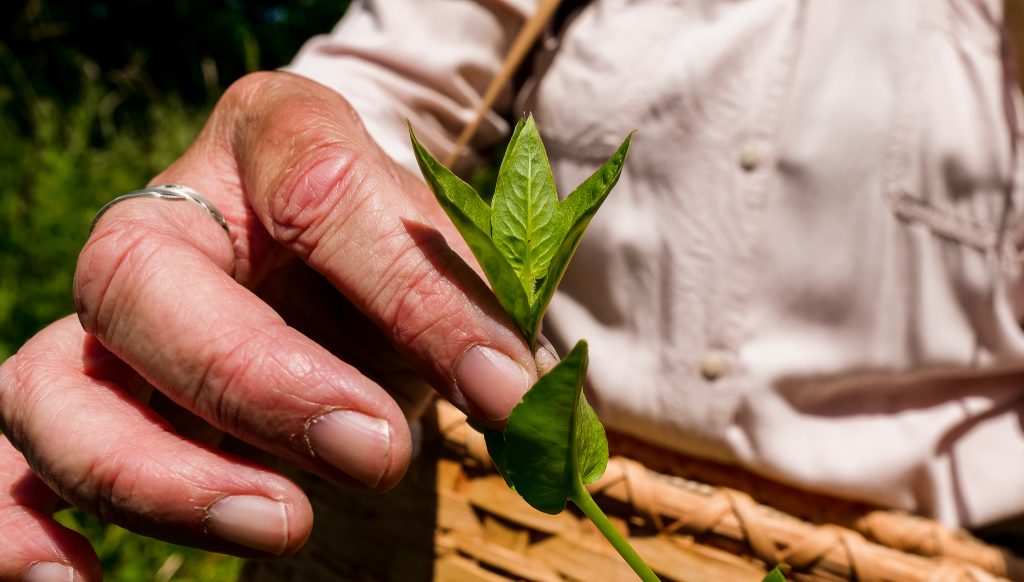
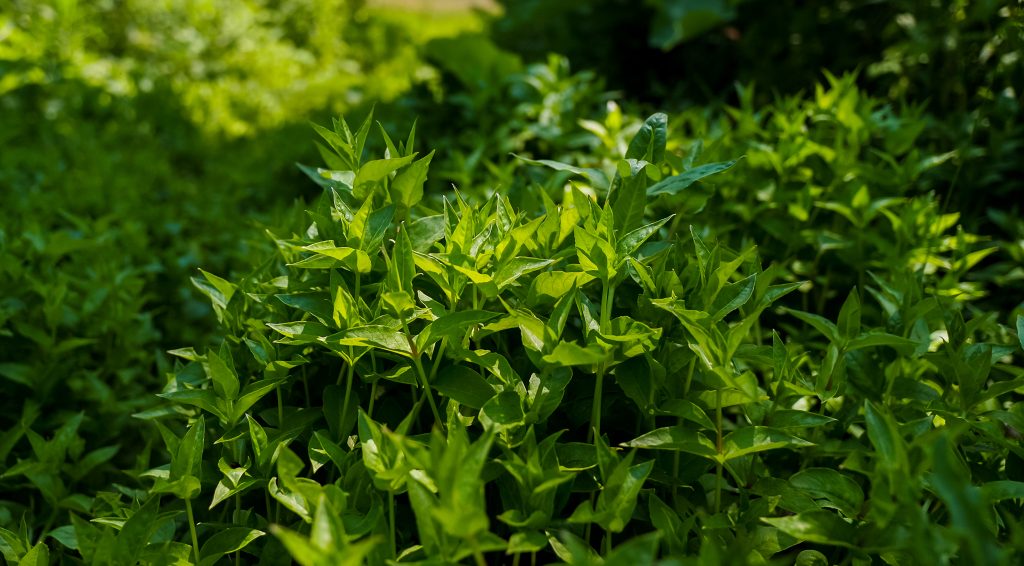
Reference Books:
Holistic Herbal, by David Hoffmann
Pages: 77-79, 138, 145, 160, 177, 191, 242
The Way of Herbs, by Michael Tierra
Pages: 13, 33, 34, 35, 118, 119
The Complete Encyclopedia of Herbs, by Nico Vermeulen
Page: 299
Family Herbal, by Rosemary Gladstar
Pages: 19, 55, 100, 102, 103, 105, 227, 284, 303, 323
Peterson Field Guide: Easter/Central Medicinal Plants and Herbs, by Steven Foster and James A. Duke
Pages: 48, 49

The Tradition of "Love Trees"
Old timers can remember the tradition of ‘Husband and Wife Trees’ well.
They recall a time when the vows had all been said and family and friends would all help plant two healthy young trees near the entrance of the farmhouse. One for the bride, and the other for the groom. Everyone participating in this happy day would help to dig the hole, plant the trees and water – and we can’t forget the secret ingredient when planting: infusing with love.
Side by side, they would grow. Basking in the warm sunshine and quenching rains. Sometimes storms would brew, but weathering these storms of life together made them stronger, more rooted because of them.
Sometimes they are close enough that eventually their branches touch, embrace even. Some never do – staying just out of reach of one another – but beneath the surface there is a bond that is so entwined we do not know where one begins and the other ends. Their roots, plant roots and mycelium are all entangled with one another, just like our families and friends are entangled with us. Helping one another, sharing water, nutrients and immunity, keeping one another strong and healthy.
But times have changed, couples have changed, and with it many traditions have become outdated. This traditional planting is slowly fading from our minds like mist on a bright sunny morning.
In this season of love, consider gifting your lover the tradition of ‘Love Trees’. Order a couple of trees and make a special date to plant this spring. A pair of trees that will represent your deep bond and commitment to one another. We have come along way from the traditional partnership of marriage – lets embrace ALL LOVE!
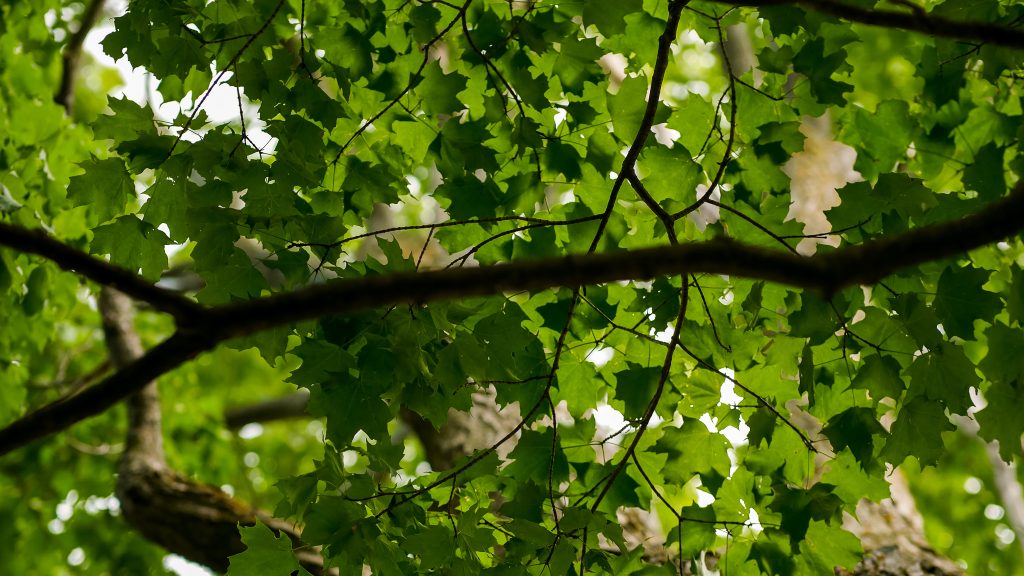
Photo provided by Serena Mor
Flaming Caesar Fire Cider Recipe
Fire Cider
What is it? Commonly an apple cider vinegar based infusion that can be made with many different variations and ingredients. Most common ingredients include; horseradish, onions, garlic, hot peppers, ginger.
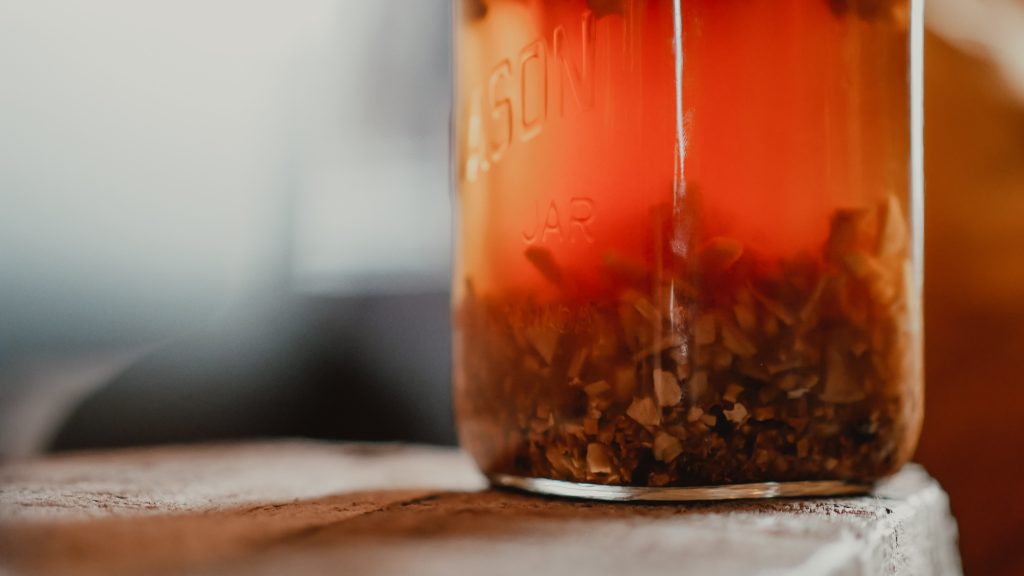
What is a Caesar?
To my American and Canadian friends, this is for you!
The wildly popular Caesar Cocktail was invented in Calgary, Alberta in 1969! It quickly became beloved by Canadians where over 350 million Caesars are consumed annually. It typically contains vodka and Caesar mix (a blend of tomato juice and clam broth, hot sauce and Worcestershire sauce, and is served over ice in a large celery salt-rimmed glass. Take a lick of the celery salt and then a drink of the Caesar through the straw.
This is my personal favourite drink! The recipe here, using our Flaming Caesar fire cider, puts it over the top for me!
Cheers!
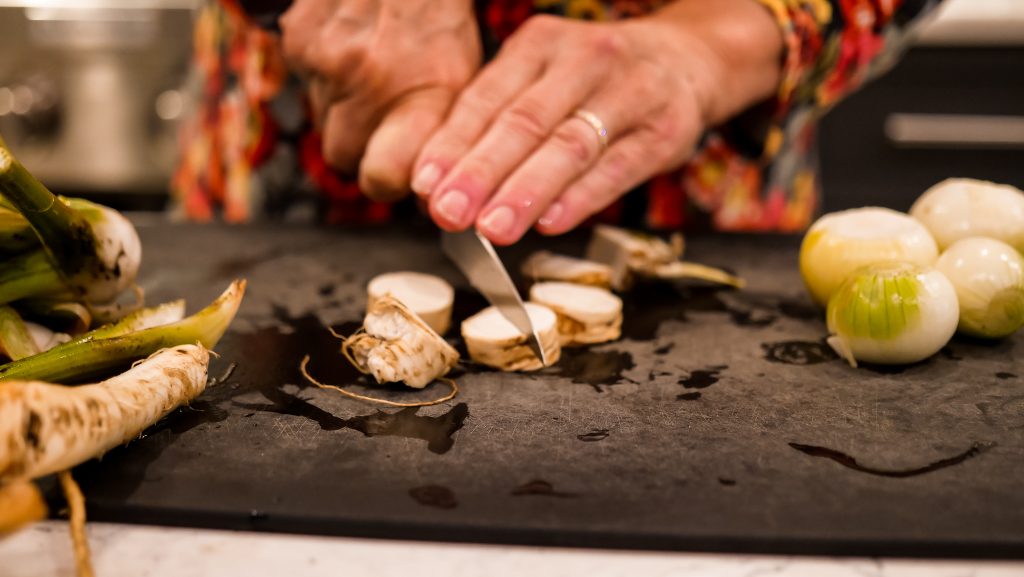
Caesar Recipe
- 8 oz of Clamato juice (may substitute with tomato juice)
- 1 oz vodka
- 1-2 tsp Flaming Caesar Fire Cider (our secret ingredient! See below to make) Top with any of these classic toppings: Celery stick, olives, pickles, pickled asparagus or beans. Many carnivores even enjoy a meat stick. Rim with celery salt. My personal favourite addition in the summer is a straw made with a hollow Lovage stalk. (Lovage plants are available in stores or online, at Richter’s Herbs)
Flaming Fire Cider Recipe
Ingredients:
- ½ cup chopped Horseradish (freshly dug is best)
- 1/8 cup garlic chopped
- ½ cup chopped Onion
- 1 Lemon (zest and juice)
- 1 Lime (zest and juice)
- 1-2 slices Jalapeno pepper
- ¼ tsp Mustard seed
- ½ tsp Red Pepper flakes
- 1 pinch Sea Salt
- 1 pinch Black Pepper
- 2-3 tsp. Celery Salt
- ¼ tsp. Paprika
- ½ tsp. Turmeric
- 2 tsp. Oregano
- 1 tbsp. Pickle juice
- 3 dashes Worcestershire
- Apple Cider Vinegar
How to Make:
- Chop your roots, and place in jar.
- Cover with vinegar.
- Add all other ingredients and shake well.
- Store jar in cool dark place for one month. Shake lovingly each day!
- Strain mixture through cheese cloth into a clean jar and label.
*Note: Organic ingredients or farm fresh are always preferred!
Goldenrod
Goldenrod
AKA: Solidago
Uses
- Used for kidney stones, urinary tract infections, bladder inflammation, digestive problems, colds and flu, sore throat, congestion, laryngitis, fatigue and surprisingly hay fever and allergies.
- Indigenous peoples boiled leaves and used them topically as an antiseptic and astringent for wound healing and relief from eczema, arthritis and rheumatism
A Little About Goldenrod
- This beautiful herb grows in plant colonies, some are 100 years old! Older, central plants may eventually die back, creating a ring, but usually colonies are too dense for other plants to invade. Surprisingly, Goldenrod has no allergens. It is not goldenrod that brings on fits of sneezing in the fall, but the inconspicuous ragweed that grows in the same conditions, the same area, and at the same time. The heavy sticky pollen of goldenrod is not wind-borne, because many different insects take over the task of its pollination.
Historically
- After the Boston Tea Party, when American colonists had dumped all the tea into Boston Harbor, they discovered they had lost their favorite beverage. Not to be deterred for very long, they found that an excellent tea could be made from the leaves of the North American goldenrod, and they named it Liberty Tea.
- The stiff stem of the plant was historically used as a divining rod, but that was only successful if used by the right person.
- Another belief is whenever golden rod grows near a house, its occupants will have good fortune. Still another holds that wherever goldenrod grows, there can be found buried treasure.
- There is also a legend about two little girls that were very close friends; one was golden blonde and the other was dark haired with beautiful blue eyes. They were afraid that when they grew up they might be parted from each other so they didn’t want to grow up. To solve their problem, the two little girls set out one day to visit the good witch who lived across the field far away. They came to the good witch after a long day of travel and told her of their wish to always be together. The little girls were never seen again, but whenever you see the golden yellow bloom of the goldenrod you will be sure to find the sweet blue aster always beside her.
Valerian: Materia Medica
Valerian
Botanical name: Valerian officinalis
Pertinent Information on the Plant
-
Nervine (relaxant, sedative)
-
Good for stress and anxiety
-
Great for cardiovascular problems
-
Nervous tachycardia (speeding up of heart rate due to stress, tension and anxiety can be helped)
-
Hypnotic (will induce sleep)
-
Anti-spasmodic (digestive spasms or colic can be relieved)
-
Sedative (calm the nervous system and reduce stress and nervousness throughout the body)
-
Headaches (Stress related, vascular)
-
Anti-depressant
-
Indigestion – due to stress
-
Gastritis – due to stress
-
Colitis – due to stress
-
Analgesics (Pain reliever for muscular, tooth ache, burns, Gall bladder, cuts, wounds, sore throat etc)
-
Dysphagia – problem with swallowing
-
Premenstrual tension
-
Menstrual cramps
-
Insomnia
-
Regulates sleep and restfulness
-
Shingles
-
Psoriasis
-
Menopause – anxiety or depression
-
Reduce sexual drive (sexual energy)
-
Carminative
-
Itching and skin rash (with burdock and Echinacea)
-
Itching from Poison ivy and poison oak
-
Strengthens and tones heart (hypertension and irregular and rapid heartbeat)
-
Herb is non addictive
-
Herb can be used long term
Habitat and Growing area
-
Widespread in damp meadows throughout Europe and is often on banks beside freshwater ponds and streams. I have many growing on our farm in Ontario. Can also be found locally on many roadsides.
Extra Notes
- Some people compare the smell of its flowers to dirty socks!
- A good ingredient in teas, especially bed time blends.
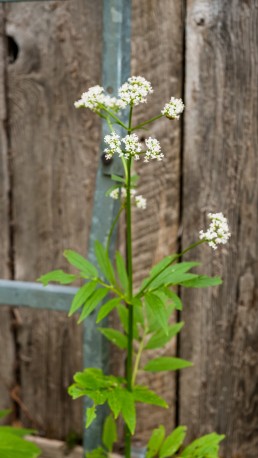
Reference Books:
Holistic Herbal, by David Hoffmann
Pages: 27, 28, 39, 53, 54, 56-60, 62, 65, 70-72, 74, 78, 86, 87, 95, 99, 101, 104, 105, 140, 143-146,159, 186, 194, 108 210, 221, 233, 238, 241
The Way of Herbs, by Michael Tierra
Pages: 12, 20, 26, 32, 34, 36, 202,
The Complete Encyclopedia of Herbs, by Nico Vermeulen
Page: 299
Family Herbal, by Rosemary Gladstar
Pages: 50, 86, 26, 48, 49, 61, 63, 69, 75, 79, 85, 88, 96, 98, 99, 101, 111, 187, 261, 277, 295, 368-70
Peterson Field Guide: Easter/Central Medicinal Plants and Herbs, by Steven Foster and James A. Duke
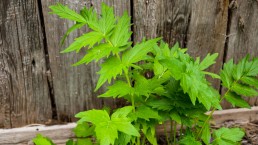
Rhubarb Shrub Recipe and Companion Plants
The Mighty Plant: Rhubarb!
Just say the word Rhubarb, and childhood memories come flooding back! My sister and I barefoot in the garden on a sunny morning, with a tin cup of sugar, picking just the right piece of rhubarb for our tasty spring treat. Ah that first bite, crunch! Oh so tart! then dip, and oh, so sweet! We waited all year for these special garden moments
Rhubarb is most often thought of as a vibrant fruit because of its sweet, tart taste, and is often found in home baking, such as a rhubarb pie, but did you know that it’s actually a vegetable? Cross my heart! Come to think of it, there is a strong resemblance to celery. While technically it is a vegetable, legally it’s considered a fruit due to a 1947 court ruling in America. Interesting eh?
Rhubarb, part of the Polygonaceae family of plants (perennial), is a unique looking plant with a remarkably interesting history. The rhubarb plant was originally used in many forms of traditional medicine, first showing up in Europe over 400 years ago. It’s fascinating to share that there are records showing rhubarb among the medicines traded along the Silk Road. Scientifically, it is an herbaceous perennial with leaves growing off the top of a thick rhizome. The leaf stalks and seeds are the only parts of the plant consumed. The heart-shaped, wide-veined leaves contain oxalic acid, which can be toxic when consumed in large quantities, so discard them before you use or store the stalks. As a gardener I love the beautiful addition rhubarb offers the landscape thanks to these large leaves and colourful stalks.
Harvesting
Rhubarb season runs from April through June. When harvesting, the stalks are carefully pulled or cut from the rhizome, and the toxic leaves are removed right away. Plants can generally be harvested for a four-week period in the third year and for around eight to 10 weeks in subsequent years.
How to Freeze Rhubarb? Simply pick and chop off the leaves, wash and pat dry the stalks. Chop into small even pieces. Put in a freezer bag and empty it of all the air (I measure 4 cup amounts because this is how much we need to bake a 9 inch pie). Put in a freezer and use throughout the year. Make sure to thaw and drain the frozen rhubarb before using it!
So, What is a “Shrub” Anyway?
It sounds all fancy dancy, but a Shrub is a super easy way of preserving fruit. Before we had refrigerators, our grandmothers were using many ways to preserve nature’s bounty. Canning, curing, smoking and dehydrating (which all sound very familiar) , but shrubs – also known as drinking vinegar – might be something new to you. A shrub is just a simple fruit syrup fortified with vinegar instead of water for preserving the essence and flavour of the plants being used. The vinegar continues to work with the sugars, and over time, creates a twist … mellowing and melding into a wonderful concoction. The tangy rhubarb shrub can be added to water, mineral water, sodas, or spirits for a refreshing tart drink. I also like to add a kick of ginger or some heavenly mint from the garden! Be inventive; try adding a splash of fruit juice, herb and spices to make a new drink each time.
Shrubs were popular during 1600s, 1700s and 1800s and has been making a come back for some time. Now appearing in specialty shops being used most commonly in craft cocktails, or mocktails. I LOVE the saying, “everything old is new again”. Ain’t that the truth!
This traditional treat is welcomed on a hot summer day or makes a lovely gift!
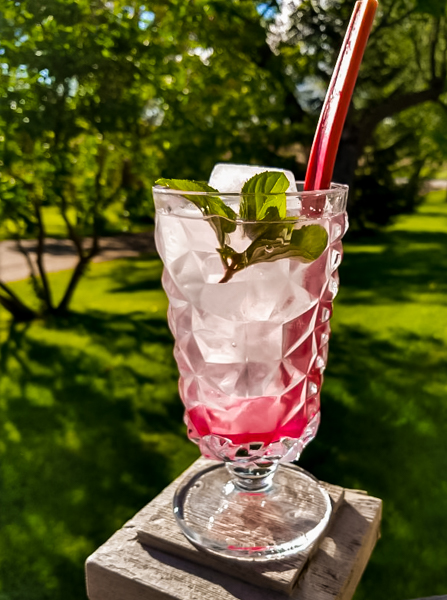
My Mom’s Rhubarb Shrub Recipe
Ingredients:

- 6 cups of freshly picked Rhubarb
- 1 ½ tsp dried ginger (optional)
- ¾ cup apple cider vinegar (can also use white or red wine vinegar or water)
- 3 hand sized pieces of Sweet Cicely leaf
- ¾ cup sugar (if not using Sweet Cicely, sugar should be 1 ¼ cups)
Directions
Wash rhubarb and sweet cicely. Combine chopped rhubarb, sweet cicely, sugar, ginger, and vinegar in a medium saucepan. Cover and bring to a boil over medium-high heat. Once boiling reduce heat to low. Cook, stirring occasionally, until rhubarb is completely broken down and strands are visible, 15 minutes.
Use a fine mesh sieve or colander lined with cheese cloth and strain mixture into a glass container. Let cool and then chill.
Voila! Shrub is ready to use.
For a refreshing drink simply add 1/8th cup (1 oz) of shrub to the bottom of a tall glass, fill with ice and top with water or sparkling water. Top with a mint leaf and small stalk of rhubarb. Optional: add a splash of juice, vodka, gin, gin smash or Tom Collins.
** Note: Any left over rhubarb can be frozen for later use. I always pick extra and bag up 4 cups of cut rhubarb with a leaf of sweet cicely for baking a pie or crisp when rhubarb is out of season.
Companion Plant Pairings for Your Garden: Rhubarb and Sweet Cicely
Plants grow better with a little help from their friends. The practice of planting different varieties of plants together is known as companion planting and can help ensure a healthy harvest of both crops. Rhubarb and Sweet Cicely are a perfect pair. They have been growing harmoniously side by side in my old vegetable garden for years. But the best part is they are ready at the same time! They are a delight to any gardener who loves Rhubarb but does not want a ton of sugary desserts. Sweet Cicely helps you to cut the amount of sugar in any given recipe by almost half. AMAZING!
Other kitchen pairings:
Sweet shrubs: strawberries or blackberries with mint, sweet cicely seeds with pineapple, or peaches with basil.
Savory shrubs: tomato shrub infused with chilies and cilantro, cucumber with fresh ginger, or celery and caraway seeds.
Medicinal Information
Sweet Cicely
- Aromatic, stomachic, carminative and expectorant. Possible diuretic
- Useful in coughs and pleurisy
- Gentle stimulant for debilitated stomachs. Useful in flatulence
- The fresh root may be eaten freely or used in infusion with brandy or water. A valuable tonic for girls from 15 to 18 years of age
- The roots are antiseptic, and a decoction is used for bites of all kinds through bugs to animal
- The essence to be aphrodisiac
- The decoction of roots in alcohol is also said to be effective for consumption
- Ointment made eases the pain of gout
Rhurbarb
- Eases digestion: the fiber in rhubarb promotes a healthy and normal digestion process and eases abdominal discomfort such as bloating and cramping
- Bone health: the vitamin k, combined with the rich amount of calcium and other minerals found in rhubarb, promote bone protection and strengthening. The high amounts of vitamin K also promotes osteotropic activity, meaning that it stimulates bone growth and repair
- Brain health: protecting the brain from neurological damage and disorders, such as Alzheimer’s
- Antioxidant: fights free radicals and keeps inflammation in check
- Relieves constipation and diarrhea: as it eases digestion, it can also relieve constipation and diarrhea
- Lowers Inflammation: the antiviral effects of rhubarb also help inhibit inflammation, making it an effective anti-inflammatory
- Aides Perimenopause and Menopause symptoms such as hot flashes.
- Menstrual cramps
- Nutrient: containing calcium, vitamin K, A and C, potassium and manganese.
- Weight loss: rhubarb is very low in calories and the high fiber content helps you feel full faster
- Heart Diseases: the high fiber content is extremely useful in lowering cholesterol levels
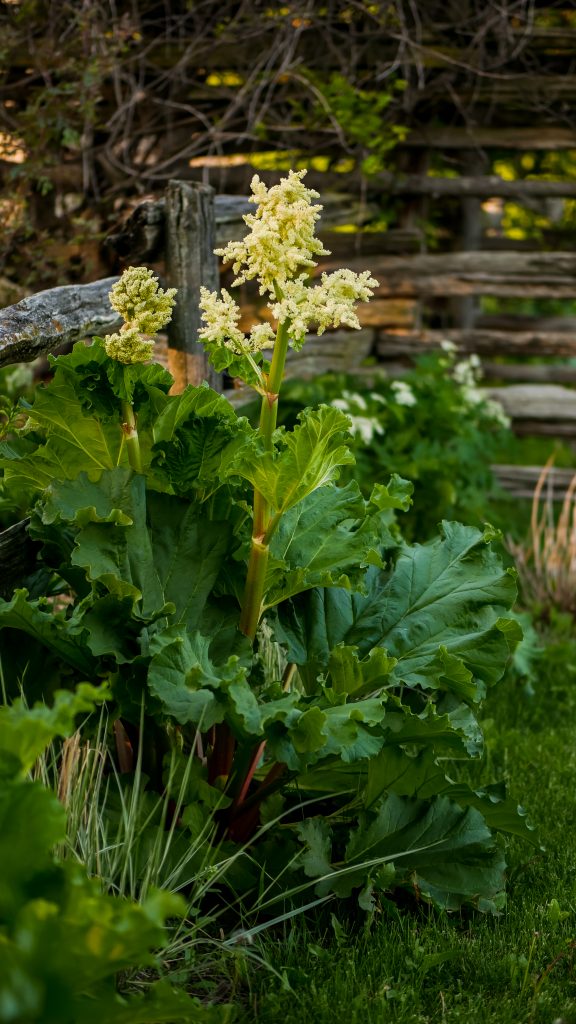
Thoughts About Ants
We Are All Connected in This Deep Web of Life…
I thought it was important to appreciate the hard work of other ‘beings’ who give so much to this great tapestry called Earth, a work of art that Mother Nature weaves continuously.
So today we are sending a short shout out to Ants! They have been a welcomed sight in our rewilding fields and sanctuary over the past thirty years.

Building amazing hills over a foot high. Within these hills and far below is a labyrinth of tunnels that aerate the soil and allow moisture to get to the roots of surrounding vegetation.
The ants – these amazing decomposers — bring other insects and leaves deep into their nest, which will decay and fertilize the neighboring plants. Ants are one of our beloved pollinators and seed distributors, working their magic throughout our gardens and fields. Ants are also an important source of food for many other essential insects, birds, and mammals.
Just the kind of insect these fields longed for – connected to the pulse of creating life and sustaining life.
